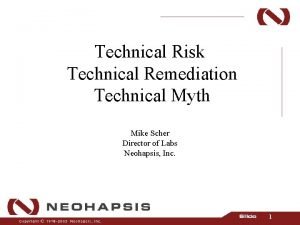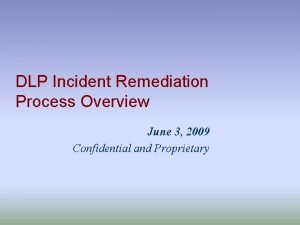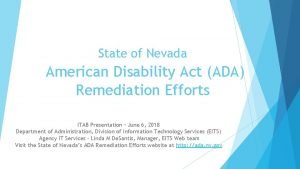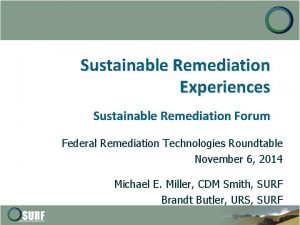Technical Risk Technical Remediation Technical Myth Mike Scher



































- Slides: 35

Technical Risk Technical Remediation Technical Myth Mike Scher Director of Labs Neohapsis, Inc. 1

Neohapsis 101 - Who we are and what we do • Information Security Consultancy with an emphasis on R&D and QA/QC • Network Computing Magazine's Chicago Lab • Producers of the SANS Security Alert Consensus Newsletter (SAC) • Security Design, Testing, Forensics 2

Managing Technical Risks • Legal Risk Management ØInfrastructure Security • Financial Risk Management (Insurance) • Risk Transfer and Due Diligence 3

Technical Risks • Risks to Systems – Process Disruption – Access to data • Risks to Data – Data can be disclosed or ‘stolen’ – Data can be altered – Data can be destroyed – Data can become unavailable 4

How Technical Risks to Data Ripen Gaps: • Lack of policy – regarding access to and placement of sensitive data • Lack of technical access controls – that implement system and data access policies • Lack of policy verification and enforcement – that audits technical access controls 5

How Technical Risks to Data Ripen Ambiguities or lapses: • Ambiguity or oversight in policy – from no authoritative source of policy interpretation • Ambiguity or oversight in application of technical access controls – from no authoritative source of technical policy planning and review 6

How Technical Risks to Data Ripen Technical failures in access controls • Complexity of technical security systems – System interactions – Unpredictable failure modes • Inability to validate security aspects of vendorprovided systems, including security systems – Technical limitations of corporate test groups – Time and materials limitations of testing – Legal limits from statute and license 7

Protections for Data • WHO - Authentication systems – – IDs Passwords Certificates Tokens • WHAT and HOW - Access control / authorization systems – Firewalls (and “intrusion prevention”) – Routers, switches – Operating system controls • WWHW Review - Audit Systems – Intrusion Detection – Logging – Event aggregation and analysis (SIM) 8

AAA • Authentication systems validate who it is • Access control systems limit what they can do • Audit Systems review who did what, when 9

Policy is Critical • Without coordination of Who, What, and How, and the ability to test and audit, security is a matter of reaction • Reactive security is costly • Reactive security is ultimately ineffectual • Policy, well-implemented and reviewed, means proactive security, anticipating needs 10

Examples of Technical Risks • External Access Controls – Too many internal applications open to outside – VPN and dial-up access based on weak access controls – Access to Internal applications dependent on 3 rd party’s security • Online Applications – User account guessing (weak access controls) – Session ID spoofing/guessing – Insufficient input data scrubbing • “SQL tampering” • Arbitrary command execution • “Cross-site scripting” • Audit Issues – No or unverifiable history of who accessed what – No ability to monitor copies of data 11

Authentication • User identification – Who do you claim to be? – Note the use of the term claim – Examples: • • a userid: a name: a SS#: An e-mail address: “jsmither” “Joshua Smither” 111 -11 -1111 jsmither@example. com – Not always unique, even on the system 12

Authentication (cont. ) • User identification + Something else = – Reasonable association of the person with the ID presented – Why “reasonable”? • • All access controls can be defeated Many can be “spoofed” Reasonability depends (ideally) on a risk analysis What does the ID guard? 13

Authentication (cont. ) • PLUS Something else (How can I reasonably assume you are who you claim to be? ) – – – – Password Digital Certificate “One-time” password (e. g. , tokens) Biometric ANI (“caller-ID”) Physical locality (including IP address) Combinations of techniques 14

Problems in Authentication • Username/Password – Easily stolen when sent “in clear” – Or via “trojan horse” programs, worms, viruses – Can be “weak” or “strong” (vs. guessing or “cracking”) • Weak: • Strong: mouser 1 (guessable) r!verb 3 d (crackable) 9 i 63 v. Dv. K – When they are memorable, they are weak – When they are strong, they are unmanageable – People almost always either pick weak passwords or they record their passwords someplace handy (perhaps protected by a single password) – Anyone can use anyone else’s password 21

Problems in Authentication (cont. ) • Digital Certificates – Large password protected by a small password – File can be taken just like any other – User’s password to activate the certificate may be • Guessed • Cracked • Snooped – More like a “rubberstamp” signature in a locked drawer • But owner may have no indication of its theft • Rebuttable presumption of identity unlikely to ever be rebutted 22

Problems in Authentication (cont. ) • Biometrics – Biometrics are static, and easily copied once known – Never-ending escalation of spoofing tricks against the reader, never-ending need to upgrade readers – Remote biometric authentication raises issues • Credentials injected into the stream • Biometric readers use a variety of cryptographic methods to ensure data integrity and reader legitimacy • At that point, biometrics are a fixed password in a public-key authentication system 23

Problems in Authentication (cont. ) • IP addresses (network locality) – Spoofable for some kinds of connections – Don’t establish that the user initiated the action 24

Authorization Systems Essentially Access Control Lists (ACLs) – On Firewalls / IPS – On Gateways and Routers – On Servers – On Workstations 27

Firewalls • Help provide an initial layer of defense at boundaries • Provide network accounting mechanisms • Can be used as a broad access control device • Some firewalls can do ACL and patternbased content control including virus filtering 28

Firewalls (cont. ) 29

Firewalls (cont. ) • All firewalls are not created equal – Proxy vs. “stateful” – Proxy vs. Proxy – Proxy vs. “IPS” • • There is no “best” firewall Don’t solve host/server-level problems Have a history of their own security problems Often provide a false sense of security 30

31

Gateways • Whose traffic goes where… and how? • Gateways don’t just include firewalls – Alternate Routers • Wireless • Dial-up • Legacy (X. 25) – Virtual Private Network (VPN) gateways • Any information security program must take all gateways to the corporate network into account. 32

VPNs • VPN: – Simulate a point-to-point, dedicated telco line as closely as reasonably possible • Identify user or remote network (authentication) • Limit access (authorization) • Log accesses and violations (accounting) 33

34

35

VPNs (cont. ) • Inherently serve one real purpose: – Make doing a very risky thing as safe as reasonably possible • Then why do we use them? – Costs – Also, costs – Oh, and costs, too. 36

VPNs (cont. ) (Not to mention, costs. ) • The Big Myths about VPNs: – inherently add security – authenticate end-users – ensure authorized use – always less expensive than dedicated telco connectivity 37

VPNs (cont. ) • Risks (especially in connecting a home user to the enterprise network) are significant – Privacy of the connection and authentication traffic – Theft/compromise of authentication credentials – End user’s system used as live gateway to private network after the user authenticates – End user fooled into authenticating to trojan gateway – Store-and-forward (time-delayed) attacks from compromised end-user system 38

Logs (audit trails) and Authentication • System logs of “who was on what system when” depend on Authentication credentials of the user • Authentication credentials are often combined for greater assurance – password + biometric + locality – token(one-time password) + password + locality 39

Intrusion Detection Systems • Misuse detection vs. Anomaly detection • Host based (HIDS) vs. Network based (NIDS) – HIDS: Active Audit trail monitoring – NIDS: Snooping network traffic for signs of malfeasance • Almost all report to a central collection, correlation and alert-generating server • Useful as an early-warning system and for trending trouble areas • Useful for some types of after-the-fact damage analysis 40

The Upshot • Defense in depth is becoming the new best practice in most industries – – – Use firewalls at least at corporate borders Use IDS internally and at borders Secure servers and put IT policies in place to maintain their security Use strong authentication devices for all remote access Use VPNs with strong authentication and limit remote users’ capabilities • Defense in depth requires coordinated, intelligent policies, risk analysis, and regular technical review • Never assume a product is so secure that it is all you need for security – even a firewall • IT staff need to get and stay up to date, reviewing new issues almost on a daily basis • Manage IT risks as a part of conducting business 41

Questions ? 42

URLs • Us: http: //www. neohapsis. com • Many security mailing list archives: http: //archives. neohapsis. com • Security Alert Consensus (SAC): http: //www. sans. org/sansnews/ • Mike: mscher@neohapsis. com 43
 Mike scher
Mike scher Paula scher
Paula scher Varignon scher apparat
Varignon scher apparat Credit risk market risk operational risk
Credit risk market risk operational risk Dlp incident management process
Dlp incident management process Remediation plan in change lifecycle
Remediation plan in change lifecycle Remediation of the struggling medical learner
Remediation of the struggling medical learner Immediacy hypermediacy and remediation
Immediacy hypermediacy and remediation Water damage somerset county
Water damage somerset county Site remediation toronto
Site remediation toronto Wcp envelope
Wcp envelope Nac remediation
Nac remediation Sox remediation
Sox remediation Eits nevada
Eits nevada Ckla assessment and remediation guide
Ckla assessment and remediation guide Risk map risk management
Risk map risk management Pestle risk classification system
Pestle risk classification system Risk projection
Risk projection Ir x cr x dr
Ir x cr x dr Inherent risk vs control risk
Inherent risk vs control risk Pembiayaan risiko (risk financing)
Pembiayaan risiko (risk financing) Risk avoidance insurance
Risk avoidance insurance Business vs financial risk
Business vs financial risk Parirt
Parirt Absolute risk vs relative risk
Absolute risk vs relative risk The biggest risk is not taking any risks
The biggest risk is not taking any risks How to calculate relative risk
How to calculate relative risk Attributable risk formula
Attributable risk formula Thinking algebraically stock market game answer key
Thinking algebraically stock market game answer key Fiduciary investment risk management association
Fiduciary investment risk management association Residual risk and secondary risk pmp
Residual risk and secondary risk pmp Elements in greek mythology
Elements in greek mythology Pueblo creation myth
Pueblo creation myth Creation myth definition
Creation myth definition Greek hero definition
Greek hero definition Ozone hole myth
Ozone hole myth

























































